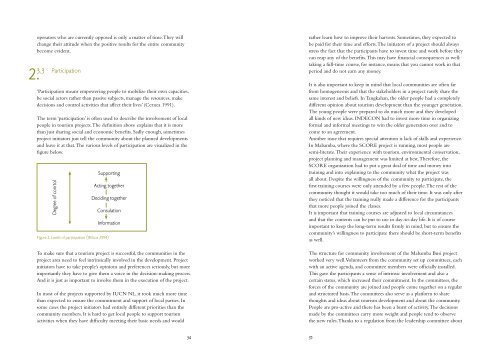OMSLAG 5.indd - IUCN
OMSLAG 5.indd - IUCN
OMSLAG 5.indd - IUCN
Create successful ePaper yourself
Turn your PDF publications into a flip-book with our unique Google optimized e-Paper software.
operators who are currently opposed is only a matter of time. They will<br />
change their attitude when the positive results for the entire community<br />
become evident.<br />
2. 3.3<br />
Participation<br />
‘Participation means empowering people to mobilize their own capacities,<br />
be social actors rather than passive subjects, manage the resources, make<br />
decisions and control activities that affect their lives’ (Cernea 1991).<br />
The term ‘participation’ is often used to describe the involvement of local<br />
people in tourism projects. The definition above explains that it is more<br />
than just sharing social and economic benefits. Sadly enough, sometimes<br />
project initiators just tell the community about the planned developments<br />
and leave it at that. The various levels of participation are visualized in the<br />
figure below.<br />
Degree of conrtol<br />
Figure 2. Levels of participation (Wilcox ,1994)<br />
Supporting<br />
Acting together<br />
Deciding together<br />
Consulation<br />
Information<br />
To make sure that a tourism project is successful, the communities in the<br />
project area need to feel intrinsically involved in the development. Project<br />
initiators have to take people’s opinions and preferences seriously, but more<br />
importantly they have to give them a voice in the decision-making process.<br />
And it is just as important to involve them in the execution of the project.<br />
In most of the projects supported by <strong>IUCN</strong> NL, it took much more time<br />
than expected to ensure the commitment and support of local parties. In<br />
some cases the project initiators had entirely different priorities than the<br />
community members. It is hard to get local people to support tourism<br />
activities when they have difficulty meeting their basic needs and would<br />
34 35<br />
rather learn how to improve their harvests. Sometimes, they expected to<br />
be paid for their time and efforts. The initiators of a project should always<br />
stress the fact that the participants have to invest time and work before they<br />
can reap any of the benefits. This may have financial consequences as well:<br />
taking a full-time course, for instance, means that you cannot work in that<br />
period and do not earn any money.<br />
It is also important to keep in mind that local communities are often far<br />
from homogeneous and that the stakeholders in a project rarely share the<br />
same interest and beliefs. In Tangkahan, the older people had a completely<br />
different opinion about tourism development than the younger generation.<br />
The young people were prepared to do much more and they developed<br />
all kinds of new ideas. INDECON had to invest more time in organizing<br />
formal and informal meetings to win the older generation over and to<br />
come to an agreement.<br />
Another issue that requires special attention is lack of skills and experience.<br />
In Mabamba, where the SCORE project is running, most people are<br />
semi-literate. Their experience with tourism, environmental conservation,<br />
project planning and management was limited at best. Therefore, the<br />
SCORE organization had to put a great deal of time and money into<br />
training and into explaining to the community what the project was<br />
all about. Despite the willingness of the community to participate, the<br />
first training courses were only attended by a few people. The rest of the<br />
community thought it would take too much of their time. It was only after<br />
they noticed that the training really made a difference for the participants<br />
that more people joined the classes.<br />
It is important that training courses are adjusted to local circumstances<br />
and that the contents can be put to use in day-to-day life. It is of course<br />
important to keep the long-term results firmly in mind, but to ensure the<br />
community’s willingness to participate there should be short-term benefits<br />
as well.<br />
The structure for community involvement of the Mabamba Busi project<br />
worked very well. Volunteers from the community set up committees, each<br />
with an active agenda, and committee members were officially installed.<br />
This gave the participants a sense of intrinsic involvement and also a<br />
certain status, which increased their commitment. In the committees, the<br />
forces of the community are joined and people come together on a regular<br />
and structured basis. The committees also serve as a platform to share<br />
thoughts and ideas about tourism development and about the community.<br />
People are pro-active and there has been a burst of activity. The decisions<br />
made by the committees carry more weight and people tend to observe<br />
the new rules. Thanks to a regulation from the leadership committee about
















